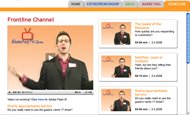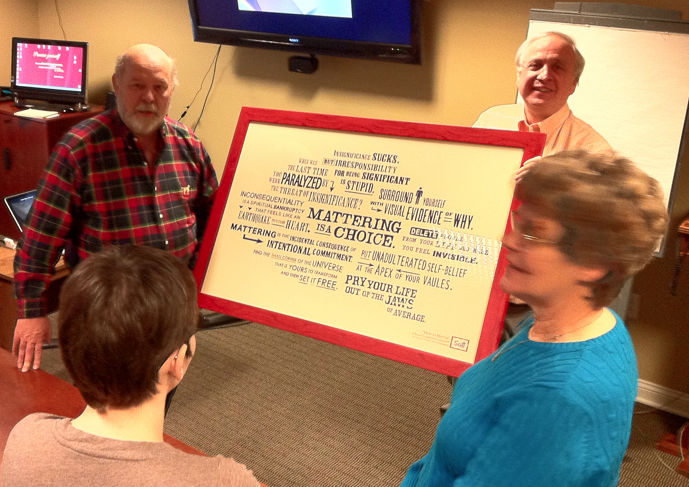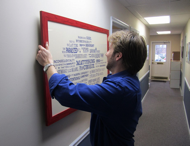 Here’s what branding isn’t:
Here’s what branding isn’t:
It’s not having a cool logo. It’s not dressing for success. It’s not self-serving competitiveness. It’s not converting yourself into a corporate clone. It’s not telling everyone you meet how awesome you are.
It’s not endless self-promotion at the expense of others. It’s not getting ahead of people and moving up the ladder. It’s not memorizing some hollow, hackneyed mission statement. It’s not puking your unique selling proposition all over everyone you meet.
It’s not integrating a sequence of promises that align with organizational initiatives.
Here’s what branding is:
How people experience you, and how people experience themselves in relation to you.
THE COOL PART IS: If your can nail those both, people won’t just buy your brand – they’ll join it.
Here’s how to make it happen:1. Don’t force your brand into a box. Here’s the problem with our hyperspeed, instant gratification culture: People who fail to summarize their brand’s uniqueness in three seconds are shunned.
Sadly, there’s all this social pressure to know how to articulate your value in a concise, intriguing and relevant manner. As if people who didn’t were the scum of the marketplace.
Excuse me, but branding isn’t that simple.
First of all, the term “branding” is finished. This is about identity. This is about bringing your humanity to the moment. Branding is for cattle. Secondly, while positioning statements are fun to come up with – and make you feel good about your value when they’re staring back at you from your shiny new website – branding isn’t some empty slogan you knock out on a Tuesday afternoon with your mastermind group.
Branding takes time. Years. And yours will evolve, just like your life evolves. Hell, mine took five years to crystallize, only to be upgraded two years later.
The point is: If you can summarize the entire scope of value that you, as a human being, deliver – in five words – then you’re doing your customers a massive disservice. Walt Whitman was right: You are large. You contain multitudes. And if you want people to join you, you have to peel the branding onion slowly. Otherwise, limiting your brand to some arbitrary, one-sentence overarching statement will limit its ability to grow into something better.
Remember: A forced brand is a forgotten one. Have you ever read Apple’s positioning statement?
2. Understand the evolving business landscape. Now, customers have the power. Now, customers make the choices. Now, customers drive the engine of interaction. And now, customers decide how much attention to give you. But if you cling to traditional ways of communicating, your brand will remain an unnoticeable blip on the radar.
One example of this principle in action is my daily fill in the blank exercise on Facebook. After running this mini experiment hundreds of times with thousands of people, I’ve discovered that it engages on several levels:
It’s fun. It’s funny. It’s organic. It taps into people’s creative flair. It meets people where they are. It flips the spotlight. It opens a direct channel. It provides free research. It doesn’t require much thought. It introduces an element of intrigue. It never has a right or wrong answer. It spices up people’s daily journey. And it gives people space to express themselves on my platform.
Look: Customers don’t want to constrict themselves into a predetermined mold; they want to create their own personal media landscape. Let them. Turn down your control freak knob and leave it up to them to close the loop. After all, people buy what they have a role in creating. They’re motivated by their own achievements, not your company’s accomplishments.
The point is, surrendering ownership doesn’t impede profit – it invites commitment. How vulnerable are you willing to make yourself?
3. Appeal to the human appetite for playful experiences. The best part about wearing a nametag every day is how much fun I get to have with people. From jokes about my memory problems to pokes about my identity crisis, the gags haven’t stopped in eleven years. And what I’ve learned from this trend is simple: Play draws people your brand’s orbit.
First, by spicing up people’s daily journey. Because when you bring your humanity to the moment, you make the moment a more pleasant passing of time. Second, play helps customers create their own game experience. That’s what allows them feel adventurous and exploratory.
And third, play creates an encounter in which anxiety is temporarily bracketed. In that safe space, people believe there is no reason not to take risks. Who wouldn’t want to join a brand like that? No wonder the Apple store is always crowded. It’s not a computer shop – it’s a jungle gym. I wonder how you could turn more of your brand moments into playful moment.
After all, branding isn’t just how people experience you; it’s how people experience themselves in relation to you. How are you letting your customers out for recess?
REMEMBER: Good brands are bought – great brands are joined.
Think about how people experience you.
Think about how people experience themselves in relation to you.
And nobody will even care what your logo looks like.
LET ME ASK YA THIS…
Is your brand buyable but not joinable?
LET ME SUGGEST THIS…
For the list called, “26 Ways to Out Brand the Competition,” send an email to me, and you win the list for free!
* * * *
Scott Ginsberg
That Guy with the Nametag
Author, Speaker, Publisher, Artist, Mentor
[email protected]
 Who’s telling their friends about YOU?
Who’s telling their friends about YOU?
Tune in to The Marketing Channel on NametagTV.com!
Watch video lessons on spreading the word!

 Authenticity is not a strategy.
Authenticity is not a strategy.
 Good brands are bought — great brands are joined.
Good brands are bought — great brands are joined.  “It’s not about the art – it’s about the person you become as you create the art.”
“It’s not about the art – it’s about the person you become as you create the art.”
 “It’s not about the art – it’s about the person you become as you create the art.”
“It’s not about the art – it’s about the person you become as you create the art.”